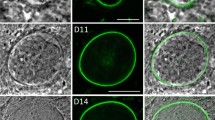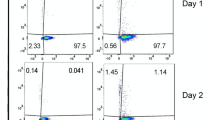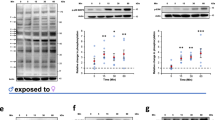Abstract
TYZZER1 found no endogenous stages in the life cycle of Eimeria acervulina in the chicken until the third day after infection when schizonts appeared in the epithelial cells of the duodenal villi, and sexual stages appeared on the fourth day. Moyihan2 observed developing forms in the epithelial cells of the crypts of Lieberkühn of the duodenum, but did not specify the stage or the time after infection. Recently, sporozoites have been shown in the glands of Lieberkühn one day after infection3–6. Doran6 gives a detailed description of the migration of the sporozoites, which develop into the first generation schizonts in the glandular epithelium by the second day after infection4–8. The mean dimensions of the first generation schizonts, which lie above the host cell nucleus, were 4 × 6µ; each one contained four to twelve merozoites5. These figures are subject to staining distortion. This newly observed stage in the life cycle of E. acervulina raises the question of whether one or two asexual stages occur after this stage and before the sexual generation, particularly because no morphological differences have so far been observed between any later schizonts developing at different times in the epithelial cells of the villi. Sections of the upper intestines of birds taken 3 days after infection show mature schizonts in the glands and in the crypts of Lieberkühn as well as developing merozoites in the epithelial cells of the villi; on the fourth day after infection there are mature schizonts and immature gametocytes, and on the fifth day gametocytes, oocysts and schizonts are present, which suggests the possibility of a total of three schizogonous stages before the commencement of gametogony and one stage concurrent with the sexual phase.
This is a preview of subscription content, access via your institution
Access options
Subscribe to this journal
Receive 51 print issues and online access
$199.00 per year
only $3.90 per issue
Buy this article
- Purchase on Springer Link
- Instant access to full article PDF
Prices may be subject to local taxes which are calculated during checkout
Similar content being viewed by others
References
Tyzzer, E. E., Amer. J. Hyg., 10, 269 (1929).
Moyihan, I. W., Canad. J. Comp. Med., 14, 74 (1950).
Ball, S. J., thesis, Univ. London (1965).
Wagner, W. H., Prog. in Protozool., Second Intern. Conf. Protozool., No. 171, 156 (1965).
Warren, E. W., thesis, Univ. London (1966).
Doran, D. J., J. Protozool., 13, 27 (1966).
Long, P. L., and Tanielian, Z., Magon. Sci. Sér., No. 6, 1 (1965).
Wagner, W. H., Z. Parasitkde (in the press, 1966).
Brackett, S., and Bliznick, A., J. Parasitol., 38, 133 (1952).
Krassner, S. M., J. Parasit., Suppl., 46, 45 (1960).
Vetterling, J. M., and Doran, D. J., J. Protozool., Suppl., 13, 17 (1966).
Author information
Authors and Affiliations
Rights and permissions
About this article
Cite this article
WARREN, E., BALL, S. Schizogonous Stages of Eimeria acervulina Tyzzer, 1929. Nature 214, 829–830 (1967). https://doi.org/10.1038/214829a0
Received:
Issue Date:
DOI: https://doi.org/10.1038/214829a0
Comments
By submitting a comment you agree to abide by our Terms and Community Guidelines. If you find something abusive or that does not comply with our terms or guidelines please flag it as inappropriate.



